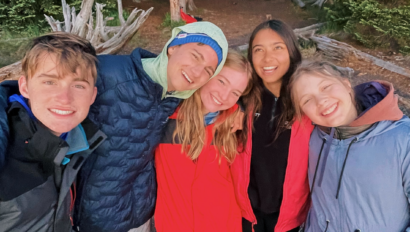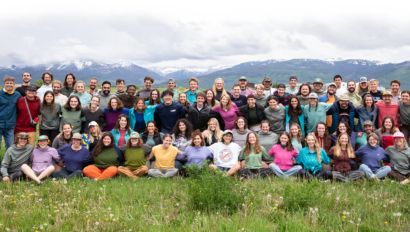
After flying a combined 7,786 miles from JFK, we arrived together in Nairobi on Monday. There, we were greeted by our guides, Jason and Grace. We then drove about 25 minutes outside the city to Indaba, a campsite across from Nairobi National Park.
The next morning, we awoke to a delicious breakfast of fresh tropical fruit salad, hot and cold cereal and toast. The Giraffe Center was our first stop that day. The center, which is part of the African Fund for Endangered Wildlife, is a sanctuary for Rothschild giraffes. Endangered through poaching and habitat loss, the Rothschild population once numbered in the 100s. Now, thanks to the center’s efforts, the population has quadrupled. Because we arrived early, before the other visitors, we were able to feed (and kiss) the giraffes. Tudor received the biggest kiss and the rest of us had the giraffes eat pellets out of our hands. After the feeding, we moved to an auditorium for a lecture about the center’s history and the fate of the Rothschild giraffe. Michael especially enjoyed the talk and asked several questions. Among other things, we learned that giraffes can run very fast (up to 50 mph) and that they have huge hearts (1ft x 2ft).
After the giraffe center, we headed to a sanctuary for another of the Big Five: elephants. The David Sheldrick Wildlife Trust, part of Nairobi National Park, operates as an elephant orphanage. Orphaned baby elephants are brought to the sanctuary, where they are raised and cared for by keepers before being returned to the wild. We were able to watch the keepers feed the elephants their lunch – a special vegetable-based milk formula. After their meal, the babies wandered over to the crowd to be petted and played with. Andreas took some close up shots with his camera and stand, while one of the more social babies got close to Lauren and tried to grab her hat with its trunk. Following the feeding, the head keeper talked about the center’s mission and the sad reality of human-wildlife conflict.
We then headed back to camp for lunch, where Grace’s brother James and his co-worker Salim had prepared pizza , green salad and pasta salad. Lunch finished, we drove to the nearby Kazuri bead factory. Matt rode with Jason in the front of the truck on the way over, and had the chance to get an insider’s view on Kenyan history and politics. Kazuri, opened in the 70s to provide work for single mothers, produces beads, pottery and jewelry that are sold all over the world. The clay for the factory’s products comes from Mount Kenya, the highest peak in the country. We received a tour of the factory, where we saw Kazuri’s 300+ employees at work. Clare modeled a bracelet in the glazing room, while Devon tried on a necklace. Outside, near the gift shop, we were surprised by a group of playful ververt monkeys, who darted among the tree braches and rooftops.
Our last stop of the day was the supermarket, where we stocked up on food for the next few days. Stephen hoped to give us a taste of Texas by making breakfast burritos, but it turned out that finding flour tortillas in Kenya was easier said then done. We opted for some more local ingredients, which we used for dinner and the next day’s lunch.
Wednesday, we started the day early in preparation for our long drive to Serengeti National Park in Tanzania. Grace, a native of Kenya, briefed us on Kenyan and Tanzanian history and culture while Jason drove. We learned about Kenya’s forty-two tribes, including the Masai, and about some of their unique marriage and coming-of-age customs. Before crossing the border, we stopped for lunch at a shop selling traditional Kenyan crafts. Patrick and some of the other boys helped prepare lunch and then browed through the shop. Regan and Sophia successfully haggled for some Masai bracelets.
Once at the border, we luckily received our Visas with little hassle. We then drove the remaining hours to our campsite, Twigar, near Serengeti National Park, excited for our upcoming safari.

